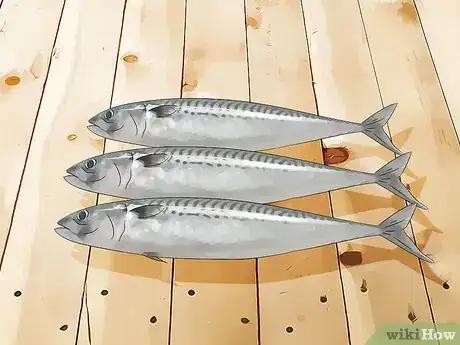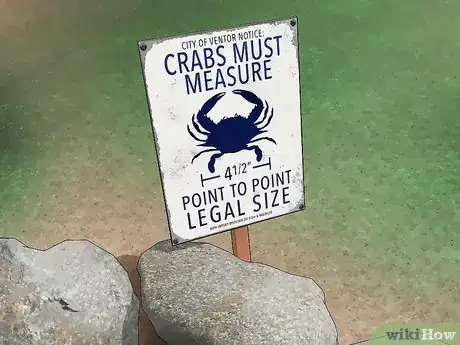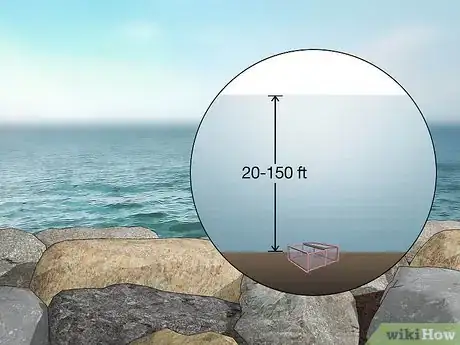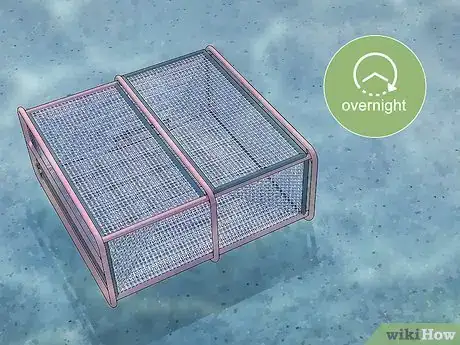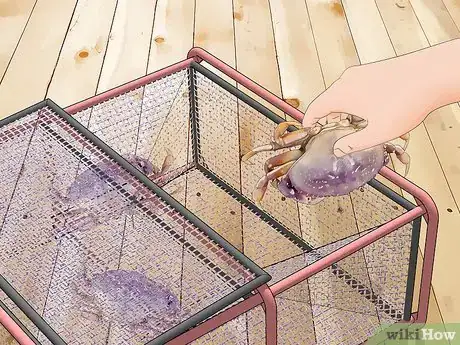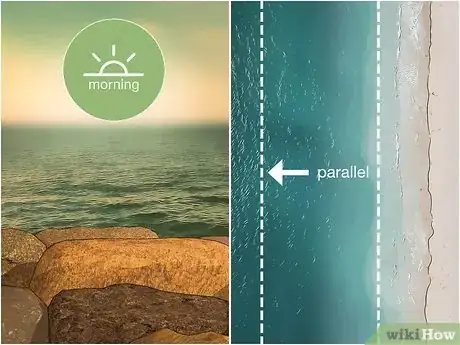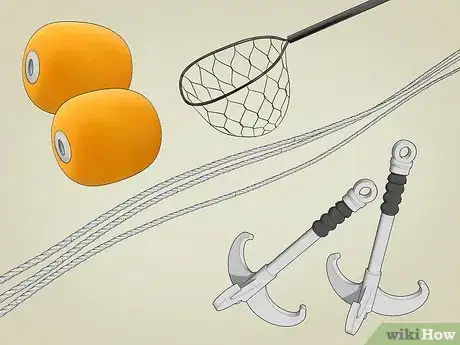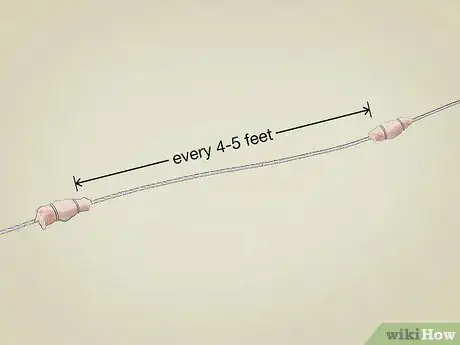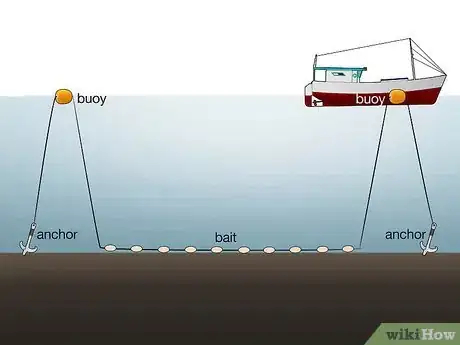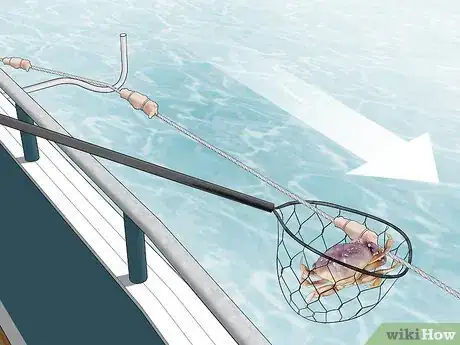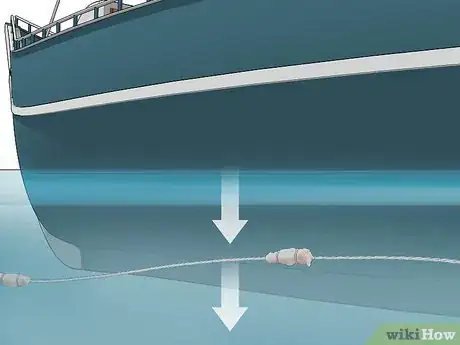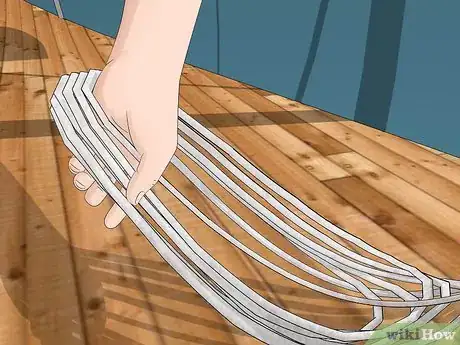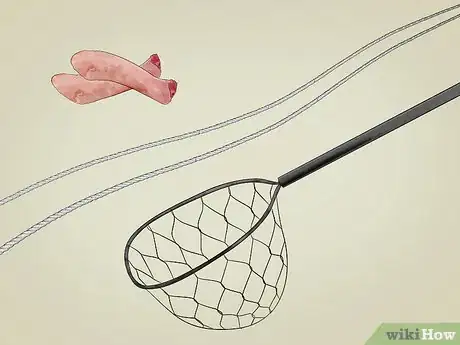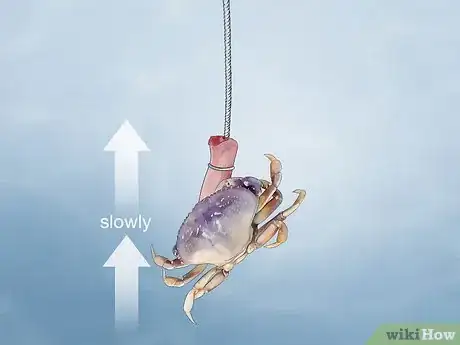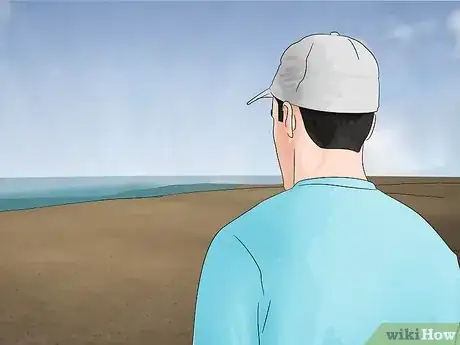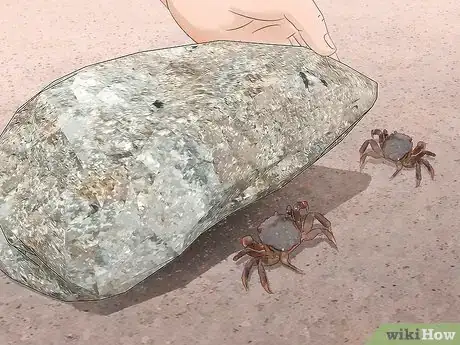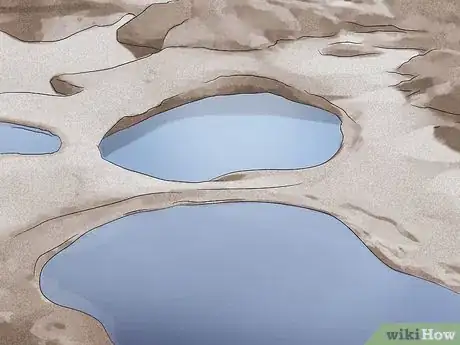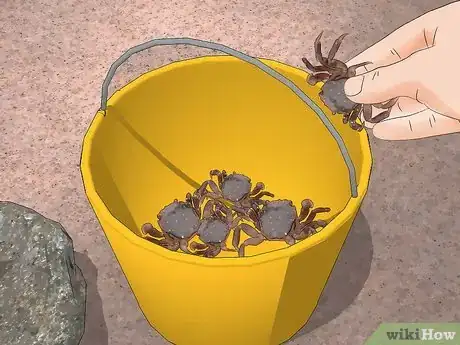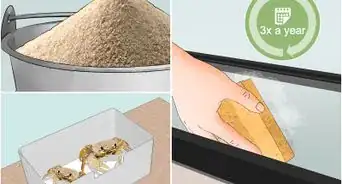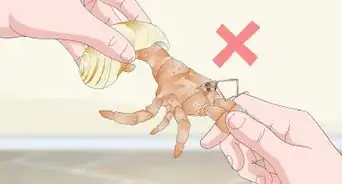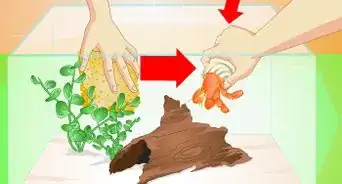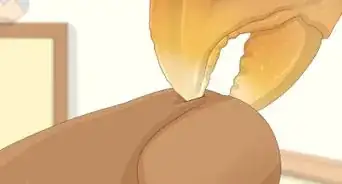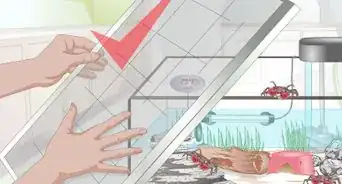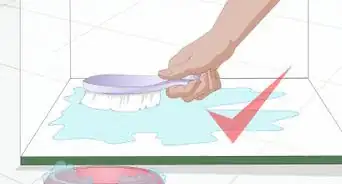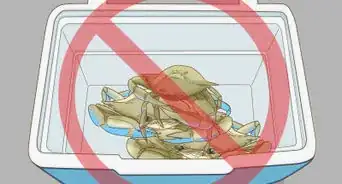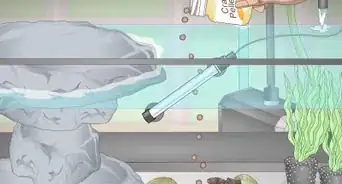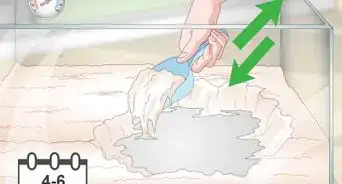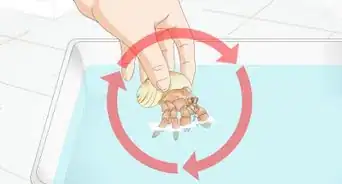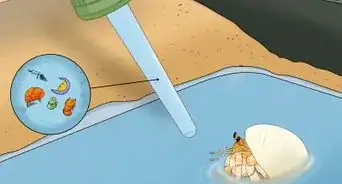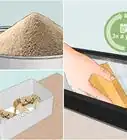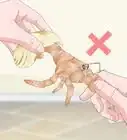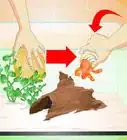wikiHow is a “wiki,” similar to Wikipedia, which means that many of our articles are co-written by multiple authors. To create this article, 25 people, some anonymous, worked to edit and improve it over time.
There are 8 references cited in this article, which can be found at the bottom of the page.
This article has been viewed 75,464 times.
Learn more...
Whether you're looking for crabs on a beach for fun, or looking to collect a few for crab cakes, you're in luck! There are lots of different methods to catching crabs that range from easy (looking on the beach, or using a hand line) to more difficult (dropping a trotline, or using a crab pot). See step 1 to get started catching a crab!
Steps
Catching a Crab With a Crab Pot
-
1Collect the appropriate crabbing equipment. Crabbers who use a crab pot tend to have a dip net (or scrap net) for scooping errant crabs, thick crabbing gloves, a crab pot, a culling stick (to help remove the crabs from the net), and a container for storing the caught crabs.
- The crab pot is a large square trap that is made out of wire (typically some sort of chicken wire). There are entrances (called "throats") where the crabs enter the trap to get the bait, which is constructed so they can't access it. The crabs then get trapped in the pot and you draw the pot back up to the surface with your new bounty.
- Depending on the area you're in you 'll have to figure whether you need a lightweight pot or a heavier one. For example: in the Puget Sound area, most areas support lightweight crab pots just fine, but a few areas, because of tidal currents and strong wave action, require heavier pots. If you're sport fishing, you typically don't want to use the commercial crab pots which are typically 75-150 lbs. (the pots sportsmen use tend to be 10 to 20 lbs.
- The culling stick helps to remove the crabs from the net or pot. You can make one yourself by cutting a 5 inch (12.7 cm) notch in a piece of wood.
- For the storage container, it is good to use a wooden bushel basket, but you can also use a cooler to store them. Mostly you just want to make sure that you keep the crabs alive until it is time to eat them and storing them in the appropriate container with ice. Leave the ice in the bag in the container and put the crabs on top of it. This will make them easier to handle when the time comes to cook them.
-
2Get the right bait. There are tons of different kinds of bait that professional and sport crabbers use. You'll have to experiment to see what works best for you, but chicken necks are a popular one, because they are scrap meat and crabs do seem to love them.
- You can use frozen fish, because it typically decomposes faster than fresh fish, which better attracts crabs.
- While crabs will eat basically any uncooked meat, you could also try some of the types commercial crabbers swear by: eel (this is one of the best ones according to commercial crabbers, but the price as risen because it is a delicacy in Europe and Asia); bull lip (durable, inexpensive, and crabs seem to love it); Menhaden, a type of forage fish, is great frozen, but decomposes very quickly, so if you're leaving the pots out for a while, you would want to use fresh Menhaden.
Advertisement -
3Be aware of restrictions in your area. Every area has different restrictions for how many crabs you can have, what kind of a license you need, the size limit for crabs, where you can crab and when you can crab. Go to your local marina and talk to the harbormaster, or your local department for Fish and Game.
- There are certain types of crabs that you'll be looking to catch and certain ones you'll need to throw back if you get them in your crab pot. Again, this will be entirely dependent on your area. For example: if you're crabbing on the East coast of the United States, you'll probably be crabbing for Blue Claw Crabs. If you catch a green crab or a spider crab, you'll need to release it, as those types of crabs aren't edible.
- There also tend to be laws in place protecting crabs with egg sacs, since these need to keep repopulating the crab population. If you catch a crab with an egg sac, make sure you release it.
- Get rid of any dead crabs that you catch. You don't know how long they've been dead, so you don't want to eat them. Stick to keeping your crabs alive until it's time to put them in the pot.
-
4Pick the right place. You aren't going to want to head out to any old body of water and dump and crab pot in there. There are specific places where crabs are more plentiful. Crabs are found in salt water, not fresh water, especially in tidal water. This type of water can include bays, inlets, the ocean, and saltwater marshes.[1]
- Again, the problem comes in with different crabbing areas and different kinds of crabs. Depending on what you're trying to catch, you'll put your pot at a different place or depth. For example: a lot of people crab off piers, because crabs often pop up around underwater structures.
- A good rule of thumb to remember is that crab pots generally need to be set between 20 to 150 feet (6.1 to 45.7 m) in the water, below the lowest tide line (this way the pot doesn't come out of the water when the tide goes out).
-
5Leave the pot out overnight. The reason most pots are left overnight is that crabs are nocturnal and that's the time when they're wandering around and looking for food. You have to make sure that you've properly marked your pot so that you can find it again and so that no boats run into the line.
- You will probably want to anchor your buoy somehow, so that it stays more or less in the same place. Attach the anchor about 2 to 3 feet (0.6 to 0.9 m) beneath the buoy, which keeps the line submerged, making it less likely that it will be cut off by a boat propeller. People usually use a brick or a metal bar as an anchor.
- Many of the rules dictate that the marker buoy has to be red and white in color and have your name and address and a telephone number. Only one person's name should appear on the buoy.
-
6Remove the crabs from the pot. Once you've left the trap out overnight, it's time to check the pot for crabs. Usually you want to pull up a trap evenly, but that is more important with crab rings, so that the crabs don't slide out.
- Remove the crab from the trap. Hold the crab properly once you've gotten the trap to the water's surface. Grab the crab by the back legs so that it won't pinch you.
- Place the live crabs in the container on the ice. They'll keep until you make it back to shore. It's best to eat the crabs within 24 hours.
Trotlining For Crabs
-
1Know when and where to use the trotline. Using a trotline can take some effort and time, but it can yield a good bounty of crabs. A trotline is basically just a line that is anchored between two buoys and set with bait. The crabs get a hold of the bait and then you draw up the line.[2]
- A good time to set a trotline is a still morning after a hot, muggy night, because the crabs tend to be running. Mornings are good to remove the trotline, because the crabs are more sluggish and less likely to release the line when you draw it up.
- The best places to set a trotline is parallel to the shore, where the bottom drops away. Typically this happens between 5 and 12 feet deep. Some people maintain that you should run your trotline over a shell bottom.
-
2Collect your equipment. Trotlining, which can yield a lot of crabs if done correctly, does require a boat. You can't set a trotline off a dock, for instance. So before you collect the rest of the equipment make sure that you have access to boat, first. You can get the different equipment online or at the marina where you'll be crabbing.[3]
- You'll need to get at two buoys and 5 lines (between 20 and 100 feet): a main line, 2 lines to attach to the buoys and 2 to attach to the anchors. For the line, there are different kinds. Decide between a yellow ¼ inch poly line or a leaded line, although some people consider the 5⁄32 inch (0.4 cm) nylon to be the best material for the main line. The poly line is less expensive, thinner, and it floats. However, it can be uncomfortable to pull up and has to be weighted so that it rests beneath the surface and doesn't get tangled up with your line. The leaded line is more expensive, but are easy to pull, coil easily, and sink on their own. Make sure that the buoys are marked with your name and address. The buoys make it so that boats are less likely to cut through your line.
- You'll want a main anchor (about 15 lbs) and an anchor for the down current end (about 5 lbs). This will keep the line from moving out of position and will allow you to find your line again. You'll also need 2 lengths of chain to weight down your line, unless you're using a leaded line.
- The dip net helps you to collect the crabs as you draw the line out of the water. It can take a bit of practice to scoop them up and deposit them in the cooler, but the more you do it the easier it will become.
- The prop stick is attached to your boat. You attach the line to the prop stick when you're running the line (pulling it out of the water). This will make the line come up more smoothly and not knock off the crabs. Along with this you'll need a gaff or hook to pull up the line from the bottom.
- You'll also need snoods and clips for hooking the bait to the main line. Snoods (also called trots) are 6 inch (15.2 cm) dropper lines with attached bait that you attach to the main line with the 3 inch (7.6 cm) stainless steel mini-clips.
-
3Prepare the line. Tie the bait onto the line using the snoods and the mini-clips. You'll do this every 4 to 5 feet (1.2 to 1.5 m) on the main line. The line needs to be weighted at the bottom on both ends with chain. You can use 2 to 3 feet (0.6 to 0.9 m) of galvanized chain. The weights will be connected to the buoys by a line, so you can draw up the line when it's time to check it.[4]
- Take the 4 smaller lengths of rope (they should be about 20 feet). Attach 1 of these ropes to an anchor, attach the rope to the buoy. Take the second 20 foot (6.1 m) rope and attach it to the same buoy and attach a length of chain to the other end of it. Attach your main line to the chain. Do the same for the other side.
- Salted eel is considered to be the best bait. Cut it into 3 inch (7.6 cm) pieces, 1⁄2 to 1 inch (1.3 to 2.5 cm) in diameter. Chicken necks or bull lips (also cut 1/2 by 3 inches) work pretty well too.
-
4Drop the line. This may sound simple, but it's difficult to focus on dropping the line and working the boat. You may need a buddy along with you to help handle the boat. You also want to make sure that you aren't dropping your line around other crabbers dropping their lines, since there is a good chance they'll get tangled up together.
- Drop the first weight and buoy. As the tide and the wind carry you, unspool the line, adding snoods and bait as you go. When you get to the end of your line, place the second buoy and drop the second anchor.
- Work your line with the wind and the tide, because it is difficult to run the line even without the boat being pushed all over the place. You'll want to let the boat drift as you're dropping the line, because that way it will follow the currents and you can focus on the line itself.
-
5Pull up the line. Once you've finished dropping the line, take your boat back to the start and use your hook to catch and slowly bring the main line to the surface of the water. Slip the line over your roller (that is mounted to the boat). Let line rise from the water at about a 30 to 40 degree angle and keep it taut.
- You'll net the crabs in the water as they come up to the surface. Be as quick as you can, because crabs tend to release the bait when they break the surface. It's often best to have 2 people, 1 to work the line and the other to net the crabs.
- Try to avoid casting your shadow onto the line, as that can cause the crabs to spook and drop off the line.
-
6Drop the line again and repeat the process. You can repeat this process several times in a morning, if you're quick about it. Once you've done the first go around, drop the line once more and make sure that you've got all the bait that you need on the line. Wait a bit once the line is set and then go through pulling it up again.
-
7Store the equipment properly. Once you're finished trolling for crab you want to make sure that you're storing your equipment properly, otherwise you won't get as many uses out of it. Different people swear by different storage methods, including putting the trotline in the freezer, but you should ask the manufacturer of your trotline, how best to store it.
- One of the main ways to store a trotline and any still-attached bait in a "pickle," a strong brine solution, that will help preserve it. Make this solution with 4 lbs of salt for every 5 gallons (18.9 L). A 5 gallon (18.9 L) bucket stores about 750-feet of 5/32-inch trotline. The consistency will be right when a raw potato or egg floats on the surface.
- Chicken necks need to be stored in a refrigerator (preferably an old one and not the main one).
Using a Hand Line
-
1Collect your equipment. Handling for crab is a lot easier than the other methods in this article and there are fewer things you need. Basically, all you need is a dip net, a line or string long enough to reach the bottom of the water, and bait.[5]
- You can handline from a boat or off a dock, so you'll need to consider that when you get your line.
- Sometimes you have to weight the end of your line so that it sinks to the bottom.
- For bait, chicken necks, eel, or fish work well. Just attach a piece to your line before you sink it.
-
2Tie the line down. You'll want to tie the line down and wait a bit so that the crabs have a chance to find the bait and get attached. You'll feel when the crab has crabbed onto the bait.
-
3Draw the line up slowly. You don't want to spook the crab so that it lets go. The bigger the crab the more likely it will be to spook and drop off, so go carefully. When it gets near the surface, scoop it up in your net.
- Pay attention to whether there is a current or tide, make sure that you place the net so that if the crab lets go it'll end up in your net and not swept away.
-
4Put the crab in a cooler. Make sure that you have ice in there so that the crab gets sluggish and easier to manage. Avoid picking them up with your bare hands. Kitchen tongs or specialized crab tongs work find here.
Catching a Crab on the Beach
-
1Go to a beach. Most beaches around the world have a type of beach crab that you can find along the shore. They vary in color, from the typically dark green common shore crab in England to the invasive Asian shore crab that has spread from its natural (and non-invasive) habitat in Asia to the east coast of the United States.[6]
- While you can find these crabs on most beaches, the rockier ones tend to be better for finding them, as the crabs like to hide under the rocks.
- Make sure you bring along a pail and small trowel or gloves. You don't really want to pick up the crabs with your bare hands, because they can pinch you, even the little crabs.
-
2Find a large rock. The really small shore crabs can hide under little rocks, or burrow into the sand, but the best places to find them are under larger rocks. They like to hide under these rocks and when you turn the rock over, they tend to go scurrying into the protection of the sand.[7]
- For example, the shore crabs of the Pacific Northwest, in the United States, (called Hemigrapsus nudus and H. oregonensis) can be easily found beneath rocks. They range from smaller than a fingertip to the size of a half-dollar.
- You can also often find Hermit crabs on rocky shorelines. Look in tide pools and beneath rocks.
-
3Check out any tide pools. This is where the crabs tend to collect to feed and move around. Tide pools are great places to find all kinds of marine life, including shore crabs. If you find a tide pool and you don't see anything at first, keep watching. There's always something going on a tide pool.[8]
-
4Pick up the crab and put it in your bucket. Put a little bit of wet sand in your bucket so that the crab doesn't dry out. You can watch it burrowing around in the sand and scuttling side to side, in the manner that crabs move. This is an especially fun activity to do with children at the beach.
- Handle the crabs gently, especially the small crabs. They do have hard shells, but they are still delicate to human handling.
-
5Put the crab back. Don't take crabs home as pets. Most places have laws and rules against removing the wildlife, which are so important to maintaining a thriving ecosystem. The little crabs that you find on the shoreline aren't worth eating.
- You should especially leave a crab alone if you see that it has eggs attached. These are the females who are waiting for their eggs to hatch and shouldn't be disturbed.
Community Q&A
-
QuestionHow can I get a crab to come out of its hole?
 ArtemisCottonCandyCommunity AnswerTo get a crab to come out, use a shovel and slowly dig deep rings around and near the hole. The crab will find it unsafe and climb out.
ArtemisCottonCandyCommunity AnswerTo get a crab to come out, use a shovel and slowly dig deep rings around and near the hole. The crab will find it unsafe and climb out. -
QuestionHow do I clean a crab?
 Community AnswerIt depends on whether you mean to cook it or clean it because it is your pet. If you mean for cooking it then you first remove the section in the center at the bottom, which gives you access to the main shell at the top. There you can start (with your fingers) pulling the soft bit at the bottom, which will reveal the insides. This part is not edible, so you clean it off with your fingers. Then you can cook it. You can find many useful videos on YouTube on how to cook and clean a crab.
Community AnswerIt depends on whether you mean to cook it or clean it because it is your pet. If you mean for cooking it then you first remove the section in the center at the bottom, which gives you access to the main shell at the top. There you can start (with your fingers) pulling the soft bit at the bottom, which will reveal the insides. This part is not edible, so you clean it off with your fingers. Then you can cook it. You can find many useful videos on YouTube on how to cook and clean a crab. -
QuestionOnce a crab goes into the pot, what keeps it from escaping?
 Sue SmithCommunity AnswerThe top of the trap is funnel-shaped so that it can enter the small opening, but it is unable to go back through it because its claws hinder it.
Sue SmithCommunity AnswerThe top of the trap is funnel-shaped so that it can enter the small opening, but it is unable to go back through it because its claws hinder it.
Warnings
- Never intentionally harm crabs and always return them to the place you found them after a while unless you plan to cook them and eat them. Only cook and eat crabs that are edible and that you are licensed to take.⧼thumbs_response⧽
References
- ↑ http://riptidefish.com/crabbing-rigging-setup/
- ↑ http://web.vims.edu/adv/ed/crab/trot.html
- ↑ http://www.bluecrab.info/crabbing/trotline.html
- ↑ http://www.daybreakfishing.com/trotline.html
- ↑ http://web.vims.edu/adv/ed/crab/hand.htm
- ↑ http://www.arkive.org/common-shore-crab/carcinus-maenas/image-A8094.html
- ↑ http://www.marinespecies.org/aphia.php?p=taxdetails&id=158417
- ↑ http://wdfw.wa.gov/fishing/shellfish/crab/identification.html
About This Article
To catch a crab, gather equipment, such as a crab pot, dip net, crabbing gloves, a culling stick, and a container to store the crabs in. Use bait such as chicken necks or frozen fish in the pot to attract the crabs, and choose a tidal salt-water area to place your pot. Wait for low tide, and place the pot at least 20 feet into the water, leaving it overnight. To ensure that the pot doesn’t move, anchor it in place and tie a buoy to the top with your name and phone number on it. Remove the crabs from the pot the next day and place them on ice to enjoy! For tips on how to catch crab from the beach, read on!

